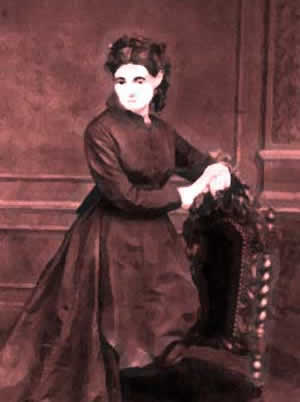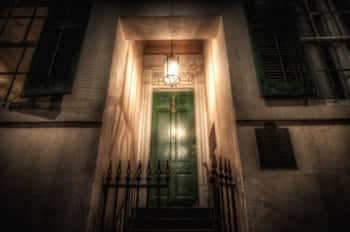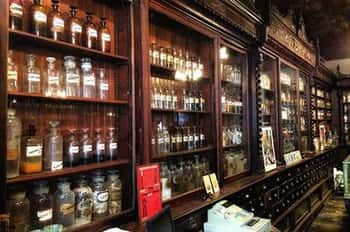
It is no secret that the LaLaurie Mansion at 1140 Royal Street is perhaps the most popular (and feared) house in all of New Orleans. It might also be the most revered house in the city as well. (Because, you know, most folks have the tiniest bit of an obsession with it).
While visitors to our lovely city will stop by to take in the awe-inspiring St. Louis Cathedral or eat at the equally haunted Muriel's Restaurant, there is no structure in New Orleans, Louisiana, which has quite the same allure, the same undefinable draw, as the gray stone building at the corner of Royal and Governor Nicholls Streets in the French Quarter. At any time of the day or night, people can be seen standing under the yellow light of Verti Marte across the street, their phones tilted up to snap a picture.
What are they hoping to capture? Maybe just the beautiful architecture of the LaLaurie Mansion, but more probably there is the underlaying hope that an orb will be caught darting across the screen, or, better yet, an actual apparition peering out of one of the 1140 Royal's many windows will be seen.
During the evening hours, the cracked sidewalks in the immediate area are crowded with tour groups, mostly of the ghost variety, all waiting to learn about the devilish, horrible acts that Madame Delphine LaLaurie committed against the slaves in her house. But what was it that she actually did?
If you believe the rumors that have circulated for decades, if not nearly two centuries now, it was in March of 1834 when things took a turn for the worse at 1140 Royal Street. Owned by Madame Marie Delphine McCarty LaLaurie, she, her third husband Dr. Louis Leonard LaLaurie and their son made themselves at home at their new property after its construction in 1832.

Delphine and Louie were the belles of New Orleans society, hosting frequent balls that everyone in town clamored over for an invitation. Those that weren’t invited were said to stand across the street, hoping for a merest glimpse of the elegance twirling about inside. (In reality, these “hopefuls” probably stuck it to the LaLauries and went somewhere else for the night). But for as beautiful and rich as these society darlings were, the LaLauries gained international fame for a much more sinister reason . . . For torturing their slaves.
The first time they were called out for such horrific acts was a few years earlier, when a young enslaved girl (allegedly named Nina, though there a few variations of her name in circulation) was combing Delphine’s hair on the third floor of the building when she suddenly caught on a snarl. Delphine, they say, stood up as though taken over by a monster, and started to stalk the little girl down the hall. Fearing for her life, Nina rushed down the hallway, running until she could run no more. Clambering out a window, Nina slipped and fell three stories to her death.
Authorities found out, especially when Delphine allegedly buried Nina’s body in the courtyard to keep her death a secret, and sent out lawyers to have a little talk with Delphine. The Code Noir (literally, the “Black Code”) laid out the rules on what could or could not be done to those who were enslaved.
Delphine didn’t learn her lesson, not according to the local stories as they’re told.
In March of 1834, the LaLauries were having another one of their infamous parties. An orchestra was set up, delicious food was laid out, and all the cool kids (i.e., the creme de la creme of society) had been invited for the festivities. In the midst of the party, the scent of smoke began to permeate the mansion. An enslaved woman was found chained to the stove in the kitchen, and she admitted to starting the fire herself.
Concerned citizens flooded the mansion, putting out the fire and ascending the steps. Behind the locked attic door, they discovered the bodies of mutilated slaves. Some were chained to the walls, other had undergone ill-done surgeries; one poor soul had been stuffed into a box, her limbs broken to fit inside.
The citizens were furious. They charged after Delphine and Louis, but both had escaped in a waiting carriage. The citizens brought the slaves who had survived to the Cabildo, where they demanded reparations for those who had been so badly treated. (They also wanted the LaLauries’ heads on a platter, but since the LaLauries had fled the area and could not be found). When nothing could be done, the angry mob went back to the LaLaurie Mansion the following morning and vandalized the entire property.
Delphine LaLaurie was never seen again. It’s thought that she died in Paris, France.
And the ghosts of the LaLaurie Mansion began to appear almost immediately after.
Did any of the above actually happen at 1140 Royal Street? Not quite.
While Delphine LaLaurie was caught for mistreating her slaves, the lengths to which the stories go aren’t true. There were no sex changes or people being stuffed in boxes; instead, her slaves were brutally malnourished, leading to inevitable starvation and death. The theory that her husband Dr. Louis Leonard had a hand in the torture is also false—apparently he’d grown so frustrated with Delphine herself, from her overall primping to her mercurial moods, that he moved out of the LaLaurie Mansion months before the fire even happened.
After all, he’d been forced to marry her after getting her pregnant. From all the accounts which have survived, Louie was not nearly as enamored with his older wife as Delphine had been with him. (Before their marriage, a surviving letter from his brother to Louie expressed the brother’s extreme disappointment that, pretty much, Louie had been unable to keep his “manhood” in his pants and was now forced to marry the worst women in town. Sounds a lot like true love—not).
Making matters more confusing was that Delphine LaLaurie’s half-sister, Marie, was an octaroon herself, meaning that she was “one-eighths black.” Delphine and her older brother acted as Marie’s godparents, bought her a house, as well as slaves, and all-in-out doted on their younger sister.
The truth of the matter is: Delphine LaLaurie was not the “monster” she’s considered to be. And by that I mean, historically, she was no worse off than any other white Creole woman of her day. Mistreating slaves was not unheard of, wrong as it may be—Delphine, however, went too far and was caught, cementing her as the “monster” that the newspapers all over the world claimed her to be.
By the 1920s, her character as the “Mad” Delphine LaLaurie became an entity all in itself, thanks to fictional works painting her as a killer. The modern American Horror Story, Coven, didn’t help any.
Her name is now spoken both with fear, awe and disgust. Ask anyone in New Orleans about the “Haunted House” and they’ll all point you in the direction of the LaLaurie Mansion. There have been stories of suicides, influenced by the mansion’s dark entities, and of people being struck by unseen phantom forces. Past owners have claimed to hear the sounds moaning and crying, and, if you believe the hearsay, corpses were discovered during a renovation period under the floors some twenty years after the LaLauries left.
Since 1834, notarial records show that no one has lived at 1140 Royal Street for more than five years, and many who do have suffered in strange ways after moving out. Death, bankruptcy (think Nicolas Cage), even insanity has been known to plague some of its former inhabitants.
But where does this leave us now?

The short answer is: We aren’t allowed to.
The longer answer to the most frequently asked question we get on our tours or in our office is: The LaLaurie Mansion is privately owned by an oil tycoon from Texas. While we’re sure he is a great guy (we don’t know him personally, but we like to think the best of people) he has made it quite clear since moving into the house in 2013 that he doesn’t plan to allow anyone of the “public” inside. In fact, if the owner and his wife are sitting outside on the second floor balcony and see tour groups gather below, they’ve been known to stand up, grab their things and head inside.
Doesn’t exactly give you the warm and fuzzies, does it?
While production crews were filming American Horror Story, Coven (Season 3), the owner did not allow filming inside of the LaLaurie Mansion or even for the exterior of the building. The inside of Delphine LaLaurie’s house was filmed at the Hermann-Grima House Museum on St. Louis Street in the French Quarter. The exterior of her house on the show was ironically filmed two houses down from the LaLaurie Mansion at the Gallier House Museum. Dirt was laid out on the street to mimic the street’s from the nineteenth century, and the show bounced back and forth between these two locations to make up the new “LaLaurie Mansion"
There have been no paranormal groups that have ever been allowed to investigate 1140 Royal Street, and it doesn’t seem that anyone will be allowed to—at least, not until or if ever the current owner sells the property.
In a city that is obsessed with learning the true hauntings of the LaLaurie Mansion, it seems a bit sadistically funny that LaLaurie enthusiasts are relegated to the sidelines, never allowed to enter but always determined to find a way.
Short of it is, y’all, no one is going into the LaLaurie Mansion. Unless you somehow make friends with the owner—and if you do, somehow invite us along!—we’ve got a good of a chance of getting inside as we do winning the million dollar lottery.
There’s always a slim chance, but roundabout slim to none.
However, if you’ve found a ghost tour promising that you will go inside “the Haunted Mansion” please be aware that you are not going inside the LaLaurie Mansion. Unfortunately, this is a ploy some tour companies make to reel you in like a fish. I’m not saying that you might not go inside of a location, but it is surely not 1140 Royal Street. These companies are capitalizing on your hopes, and it’s a shame that they’ve got to take that stance.
After all, everyone in New Orleans knows that the LaLaurie Mansion is off-limits. As a tourist or visitor to the city, it’s unlikely that you would know, and nothing is worse than being promised something, not having it be delivered, and be let down in the process.
If you’re keen on visiting the filming locations for the show, the Buckner Mansion (also off-limits to tours, but still utterly beautiful) was the school in Coven and can be found Uptown. For a bit more of an interactive experience, we definitely recommend visiting the Hermann-Grima House Museum in the French Quarter. It’s a house museum with artifacts dated to the 1850s, with its own ghost stories to tell. The Hermann-Grima House is a stop on our Killers and Thrillers Tour, though you do have to visit the museum during the day to venture inside.
While walking past the LaLaurie Mansion on Royal, be sure to note the property two houses down at the Gallier House for a glimpse of the “outside” of Delphine’s mansion from the TV show. The Gallier House is another house museum and open to the public for tours.
And, of course, if you’re looking for the best ghost tour in town which explains what really happened to the LaLauries, be sure to take our Ghost of New Orleans Tour or our Bad Bitches of New Orleans Ghost Tour. We’ve done the extensive research. We’ve looked through the archives. If you want to know the truth, look no further: Ghost City Tours will deliver it and some more.
Is the curse real at the LaLaurie Mansion? On our New Orleans Ghost tours you will hear the entire story of Madame LaLaurie and the ghosts and hauntings that happen with regularity at the LaLaurie Mansion. We promise, the story you'll hear on the ghost tour is one that you won't forget anytime soon.
Many people ask us if you can tour the LaLaurie Mansion. While you cannot go inside, if you join us on a Ghost Tour, you'll visit this haunted house.

Was this the site of a grizzly mass murder?

New Orleans' most haunted Cemetery

Who haunts this museum, and why?